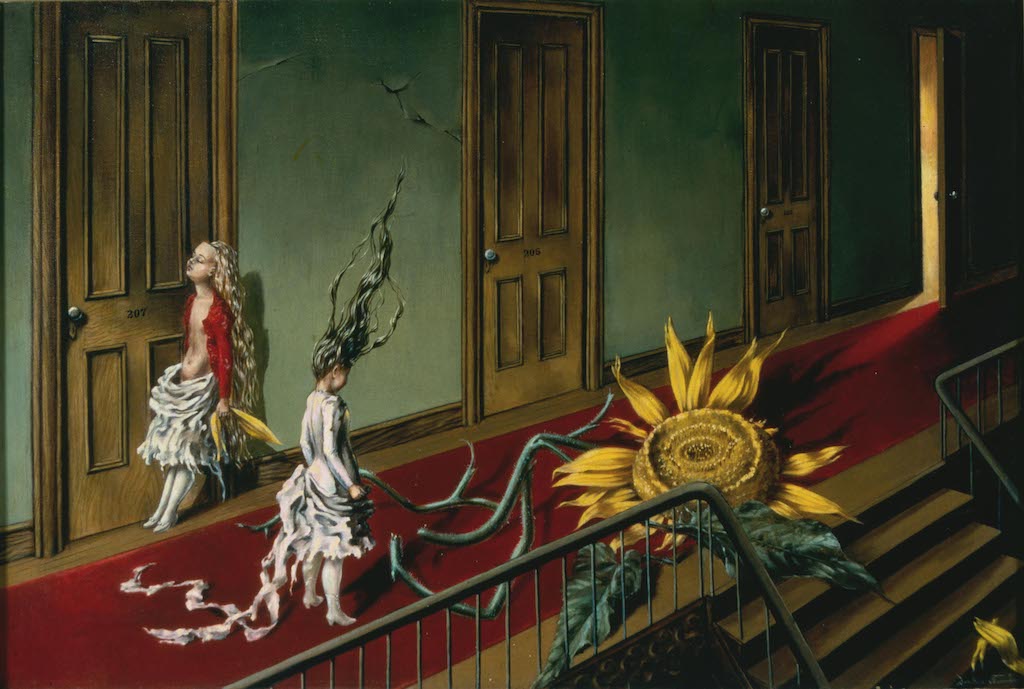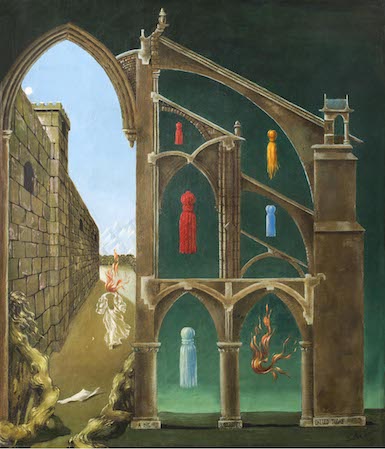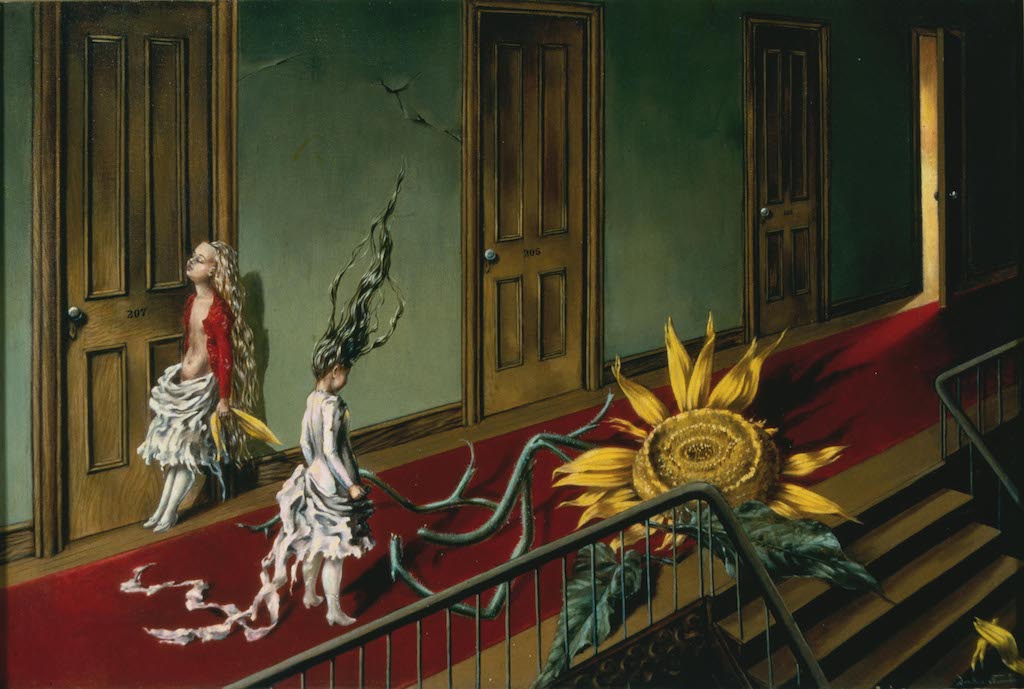[ad_1]

Dorothea Tanning, Eine Kleine Nachtmusik (A Little Night Music), 1943, oil on canvas.
TATE, ACQUIRED WITH THE SUPPORT OF THE ART FUND AND THE AMERICAN FUND FOR THE TATE GALLERY, 1997
For years, Dorothea Tanning was one of the lesser-studied Surrealists, known mainly for just a few works, particularly Birthday, her 1942 self-portrait in which she appears alongside a mutant bird-like creature. She was also classified as one of the few women involved with the movement—an erroneous understanding, she often said—and was regularly referred to as “Max Ernst’s wife.” In the past two decades, however, her renown has grown, and a full-dress Tanning retrospective is currently on view at the Reina Sofia Museum in Madrid. With that show in mind, republished below, with permission from its author, Michelle Falkenstein, is a profile of the artist from the September 2001 issue of ARTnews. At the time, the artist was 91 (she died in 2012 at age 101), and she said that she was “alive in every way.” The article follows in full below. —Alex Greenberger
“The Oldest Living Surrealist Tells (Almost) All”
By Michelle Falkenstein
September 2001
With two shows this month and a just-published memoir, 91-year-old Dorothea Tanning is still “alive in every way”
“I’m an old has-been to a lot of people,” says Dorothea Tanning, 91, folding her hands over her knees. “But I’m still alive in every way.”
Tanning, best known as a Surrealist artist, has worked steadily her entire life, making paintings and sculpture, writing poetry and fiction, designing costumes and stage sets for Balanchine, even drawing plans for a house and having it built in the South of France. “That’s what a motivated life is,” she says. “It’s creative in every sense.”
Beginning on the sixth of this month, Manhattan’s Zabriskie Gallery will have a small survey of Tanning’s drawings, collages, and soft sculptures on view through October 13. Farther downtown, La Maison Française of New York University will feature a selection of her drawings, watercolors, and gouaches that runs through the end of September.

Dorothea Tanning, Birthday, 1942, oil on canvas.
PHILADELPHIA MUSEUM OF ART
Tanning offers details of the projects and people who have defined her motivated life in the recently released Between Lives: An Artist and Her Work (W.W. Norton & Company). She describes the book as an expanded version of her earlier memoir, Birthday (Lapis Press, 1987). “Birthday was a kind of love story, mostly about my life with Max Ernst, because I was mourning his loss,” says Tanning, who met the Surrealist painter in 1942, when he came to her New York studio to look at her work. She married him four years later in Beverly Hills, in a double wedding with Man Ray and Juliette Browner. “But,” she adds, “you can’t mourn someone forever, can you?” In the years after the publication of Birthday, Tanning says she realized that there were many people in her life whose stories she hadn’t shared, including Joseph Cornell, Alberto Giacometti, Jean Arp, John Cage, and André Breton. There was the time, for instance, when Marcel Duchamp painted a mustache and goatee on a dime-store reproduction of the Mona Lisa that Ernst had been given as a mock prize at a party. On another occasion, Virgil Thomson pleaded with her to jab him with an elbow whenever he dozed off during a cello concert that he was reviewing for the New York Herald Tribune. The thought that such incidents might not otherwise be recounted led Tanning to write Between Lives. “I vowed not to make it a name-dropper,” she says. “But the people deserved to be mentioned in this adventure which is my life.”
There would have been two books this year, if not for Tanning’s decision to stop the publication of her first novel, Chasm, an enigmatic tale set at a desert ranch, because she didn’t approve of Turtle Point Press’s marketing copy. She particularly disliked a description of her as “one of a small group of major women artists who worked in the Surrealist milieu,” along with references to Ernst, she says, which she felt were unnecessary. “He was part of my life for 35 years,” she explains, sitting in her lower Manhattan apartment wearing a colorful checkered sweater and pink lipstick. “But I’ve had 55 others.” Ernst died in 1976.
The feisty and trim Tanning continues to work every day, though mostly on her poetry. The apartment, where she has lived since returning to the United States in 1978, after 28 years in France, is filled with works by her, Ernst, and numerous other artists, along with tribal masks and sculpture. A 19th-century bust by Carrier-Belleuse that Tanning draped in strands of colorful plastic beads and a chair she upholstered in leopard-patterned fabric and to which she attached a long tail are among the oddities that speak for Tanning’s playful and inventive nature.
Tanning says she had as much an affinity for writing as for visual art while growing up in Galesburg, Illinois. “When I was very young, there was a moment when I was seriously trying to decide what to do,” she recalls. “My talent for drawing came faster and easier—and it provided me with a living.” Early on, Tanning supported herself as a commercial artist, producing fashion drawings for Macy’s, among other projects, before devoting herself full-time to fine art. In the late 1940s, Manhattan gallerist Julien Lévy represented her work. Today, her art is handled, for the most part, by New York dealer John Cavaliero, who says that her early pictures regularly “sell for over $300,000.”

Dorothea Tanning, A Mrs. Radcliffe Called Today, 1944, oil on canvas.
PRIVATE COLLECTION
Four years ago, when she was 87, Tanning decided to use the fine, large Lefebvre-Foinet canvases that she had brought back from France when she returned to New York. “I thought, I am not going to die and let someone else paint on these beautiful canvases!” Tanning says emphatically. She created a series of imaginary flowers—12 in eight months. “I don’t know how it happened,” she says. “I usually chose more challenging subjects.”
Upon seeing the new canvases, hazy compositions that border on abstraction, the poet W. S. Merwin suggested that each should have a poem. Then, as now, most of Tanning’s friends were poets. Merwin’s idea became the basis of a book called Another Language of Flowers (George Brazillier, 1998). It includes reproductions of all the paintings and 12 short poems by such poets as Adrienne Rich, John Ashbery, and, of course, Merwin. Tanning’s own poetry has appeared in such literary journals as The Paris Review and Partisan Review, and one of her poems, “No Palms,” was included in The Best American Poetry of 2000 (Scribner).
Outside of a few images, Tanning’s work is not well known in the United States. Her first solo show at an American institution opened last November, at the Philadelphia Museum of Art. The exhibition, “Birthday and Beyond,” celebrated the museum’s purchase of Birthday (1942), a self-portrait of the artist in exotic dress that is widely considered an icon of Surrealism, and showcased 19 of her other works. “The idea for the show was really prompted by our worry that people would think that Dorothea Tanning had made on great painting,” says Ann Temkin, curator of modern and contemporary art and one of the show’s co-organizers. “We wanted to provide a welcome for the painting that made it clear that Tanning had six decades of painting, sculpture, and writing.”
“Tanning is an interesting artist who has been overlooked in many ways—except for her relationship with Max Ernst,” says Sidra Stich, curator of “Anxious Vision,” a traveling exhibition of Surrealist art organized by the Berkeley Art Museum in 1990. “Some of her early work has a character all its own and warrants particular attention.” As an example, Stich points to Children’s Games, completed in 1942. It depicts two young girls tearing wallpaper off the walls in a hallway, with one revealing what appears to be a vaginal opening, the other an anal one. The pubescent legs of one girl poke into the picture at the lower left; in the background, a de Chirico–like doorway reveals a cloud-filled landscape and two small hills. “The piece is so incredibly strong, even though it measures only 11 by 7 inches,” says Stich.
Robert Waddell, curator of prints at the New York Public Library, co-organized “Dorothea Tanning: Hail Delirium!” in 1992, after Tanning and 12 other donors gave nearly 130 works on paper to the library. “Her work as a printmaker had no been celebrated in this country as it had in France,” Waddell notes. “The wonderful thing about Tanning is her appreciation for the accident. There’s a wonderful element of chance and spontaneity, and her colors just glow.”
When she thinks about the art world now, Tanning says, she senses among the public nostalgia for painting that is more ambiguous with regard to its meaning, a quality she finds essential to great art. Of today’s art, she says, “It doesn’t allow for imagination or poetry.”
Art should console people for living, Tanning believes. “If it doesn’t cheer us up, then why look at it?” she wonders. “It should make us feel good about life, or at least make us think about the big questions, the things that people don’t want to ask themselves anymore.”
A version of this story originally appeared in the September 2001 issue of ARTnews on page 146 under the title “The Oldest Living Surrealist Tells (Almost) All.”
[ad_2]
Source link

